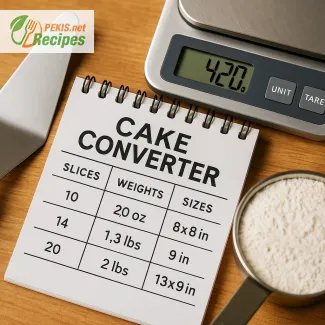
Scaling recipes becomes effortless when you know how to use a cake converter. By keeping the right balance between flour, sugar, eggs, and fat, you maintain consistent texture whether baking for two or for a crowd. Adjusting slice counts, pan sizes, and baking times ensures reliable results without guesswork. From traditional European methods to modern digital tools, converters let you create cakes that are precise, waste-free, and perfectly adapted to any occasion.
Mastering cake converter tips for effortless baking success
From portion sizes to weight conversions for perfect cakes
Understanding how to use a cake converter can transform your baking experience. When you shift between slices, weights, and pan sizes, precision is the key to keeping your cake light, moist, and beautifully balanced. Whether you are scaling down for a smaller family gathering or enlarging a recipe for a celebration, a converter ensures your results remain consistent.
The origin and evolution of cake conversion methods
Long before digital tools, bakers relied on handwritten notes and simple ratios to adapt their favorite recipes. Traditional European patisseries developed methods for dividing batters into equal portions, while American bakers popularized cup-based conversions. Over time, the need for more accurate calculations led to specialized charts, kitchen scales, and eventually modern cake converter tools that combine tradition with practicality.
Why a cake converter matters in modern baking
Using a converter provides structure and removes guesswork:
- Consistent texture – avoid dense or dry results by balancing flour, fat, and liquid correctly.
- Flexible portions – easily adjust from 8 slices to 12 without altering flavor.
- Pan size adaptations – switch from round pans to sheet trays with confidence.
- Waste reduction – measure only what you need, saving ingredients and money.
Core principles behind accurate cake conversions
To achieve the best results, certain principles always apply:
- Ratio of ingredients: Maintain the relationship between flour, sugar, eggs, and fat.
- Baking time adjustments: Larger cakes require longer baking at slightly lower temperatures.
- Volume vs. weight: Weighing is more accurate than volume measures, especially for flour and sugar.
- Frosting and filling: Scale these alongside the cake to ensure complete coverage.
Practical ideas for everyday baking
- Converting servings: Turn a family-sized chocolate sponge into a mini treat for two.
- International recipes: Adapt British Victoria sponge measures into American cups or vice versa.
- Festive cakes: Double the recipe for Christmas fruitcake without losing texture.
- Layer adjustments: Convert a single-layer sponge into a multi-tier wedding cake.
- Dietary swaps: Use the same ratios when replacing butter with plant-based alternatives.
Simple tricks to make conversions seamless
- Always start with the original recipe as your baseline.
- Use a digital kitchen scale for maximum accuracy.
- When increasing size, reduce oven temperature by 10–15°C (around 25°F) to prevent overbrowning.
- Keep a conversion chart or cake converter app at hand for quick checks.
- Round measurements sensibly; a few grams up or down won’t spoil a cake, but large deviations will.
Useful combinations that inspire creativity
- Classic pairings: Lemon sponge scaled up into a sheet cake for spring gatherings.
- Modern fusions: Red velvet converted into mini muffins for bite-sized indulgence.
- Cultural blends: Italian panettone converted into smaller loaf tins for gifting.
- Everyday treats: Banana bread adjusted into cupcake portions for lunch boxes.
Inspiration from traditional and contemporary kitchens
- Traditional: Bakers in France and Austria perfected weight-based methods for precise patisserie.
- Contemporary: Today’s home bakers experiment with vegan batters, gluten-free blends, and trendy pan designs—all requiring conversion know-how.
- Fusion trend: Converters allow classic recipes to be reshaped into modern desserts like cake pops, jar cakes, or layered trifles.
Step-by-step approach to reliable cake conversions
- Identify servings: Decide how many slices you need.
- Check pan size: Compare the base area of pans and adjust volume accordingly.
- Apply weight ratio: Multiply ingredients proportionally.
- Adjust baking time: More batter requires slower, steadier heat.
- Review decoration needs: Don’t forget to scale fillings, frostings, and toppings.
- Check: calculators
A cake converter is more than a tool; it is a gateway to creativity and consistency. By mastering these principles, you ensure every sponge, brownie, or layered masterpiece turns out as intended—no matter the size, shape, or serving requirement. From classic traditions to modern twists, the ability to switch effortlessly between weights, slices, and pan sizes keeps your baking adaptable, efficient, and delicious.
FAQ questionWhat is a cake converter used for?
A cake converter helps you adjust ingredients, pan sizes, and serving portions without losing consistency in texture or flavor.
FAQ questionCan I use a cake converter for any type of cake?
Yes, you can apply conversions to most cakes, from sponge and fruit cakes to modern layered desserts, as long as you maintain the correct ingredient ratios.
FAQ questionHow do I adjust baking time when scaling a cake?
When increasing size, reduce the oven temperature slightly and bake for longer. Smaller cakes usually need a shorter time at the original temperature.
FAQ questionIs weighing ingredients better than using cups?
Using weight measurements is more accurate, especially for flour and sugar, ensuring reliable results across different recipes.
FAQ questionDo I also need to scale the frosting and fillings?
Yes, frosting, fillings, and decorations should always be scaled along with the cake to ensure even coverage and balance.
FAQ questionCan I convert cakes between metric and imperial measurements?
Absolutely, a converter makes it simple to switch between grams, ounces, cups, and tablespoons, depending on the recipe you are following.
PEKIS – a professional chef and recipe developer with over 25 years of experience, specialized in European and international cuisine. For this cake converter guide, I’ve drawn on years of working with scaling recipes, adapting pan sizes, and ensuring precise portions in both home baking and professional pastry kitchens.